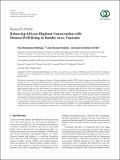Balancing African Elephant Conservation with Human Well-Being in Rombo Area, Tanzania

View/
Date
2017-05-31Author
Mmbaga, Naza
Munishi, Linus
Treydte, Anna
Metadata
Show full item recordAbstract
The critical assessment of the nature and extent of human-elephant conflict (HEC) and its impact on conservation efforts are
essential if we are to meet the challenges related to extinction of local population, as well as loss biodiversity. Conservationists need
detailed information on HEC in areas where these challenges prevail to improve intervention in the face of limited funds/resources.
We assessed the status of HEC at Rombo area over the last six years. Data based on household surveys, focus group discussions,
spatiotemporal analysis of site observations, and reported incidents of damage within the last six years were mapped. Out of all
HEC cases analyzed, the most were crop damage which took place at night and the damage was severe between May and July,
when cereal crops were mature. In upland areas of Rombo, HEC hotspots were observed inside the protected forest plantation
where local people cultivated their annual crops. Cold spots concentrated in upland areas outside the protected forest plantation
dominated by settlement and agroforestry less preferred by elephants. In lowland areas,HEChotspotswere observed in village lands
close to the PAs, within settlement and farmland dominated by seasonal crops. This suggests that HEC management efforts such
as establishment of buffer zones should be directed around the areas adjacent to PAs and prevention should focus on cultivation
of the alternative crops and farming systems that are less preferred by elephants. Our study highlights the importance of using a
combination of data collection techniques to pinpoint fine-scale HEC hotspots in a highly conflict-prone location of Tanzania.
